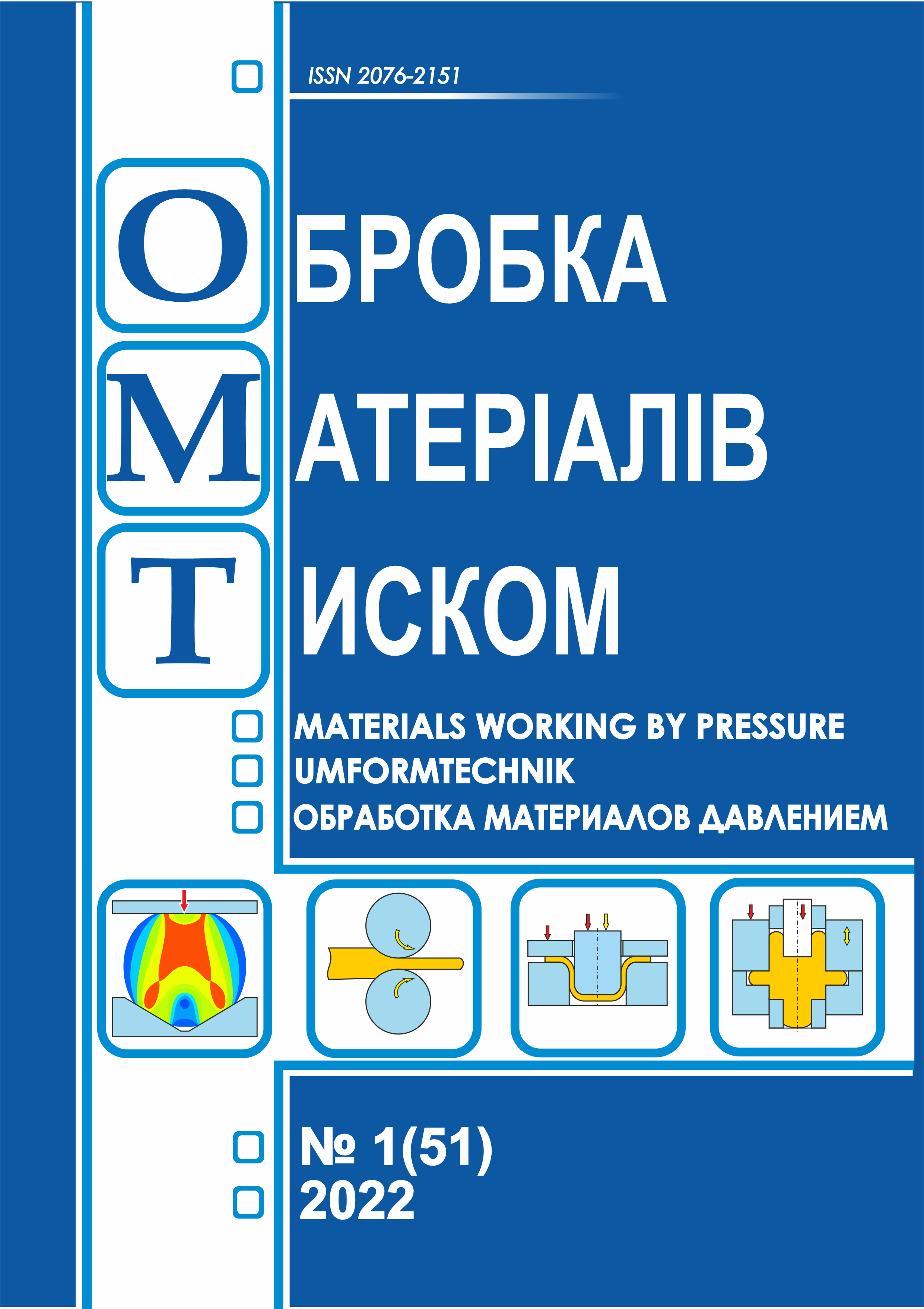Energy consumption and emulsol spending during cold flat rolling of carbon steel on a continuous 4-stand mill 1680
DOI:
https://doi.org/10.37142/2076-2151/2022-1(51)134Keywords:
cold rolling, 1680 continuous mill, emulsol, energy consumption, specific consumption of electricityAbstract
Kukhar V. V., Hornostai V. M., Kurpe O. G. Energy consumption and emulsol spending during cold flat rolling of carbon steel on a continuous 4-stand mill 1680
The paper compares energy consumption during cold rolling on a 4-stand mill 1680 of carbon steel assortment using "Quakerol" and "Universal-1TS" lubricating-cooling emulsols. The object of the study was the manufactury process for cold rolled strips in the cold rolling shop. The subject of the study were regularities of the technological conditions influence for cold rolled strips production on a four-stand mill 1680 with the use of "Quakerol" and "Universal-1TS" emulsions on the rolling energy and power parameters. It was found that the average total load on mill's stands motors and winder when using "Quakerol" emulsion is on 4.19% higher than when rolling the same assortment rolled with emulsion from "Universal-1TS". It is shown that the total specific consumption of electricity when rolling on an emulsion prepared from the experimental "Quakerol" emulsol is 2.7% more than rolling on an emulsion prepared from the serial "Universal-1TS" emulsol. The assumption is substantiated that higher specific power consumption in the operation of lubricant-coolant from experimental emulsols, which has a higher saponification number, can be the cause of incorrectly selected and emulsion underestimated concentration in order to reduce the emulsol consumption for the rolling process. It was established that the total consumption of the "Quakerol" emulsion was 0.151 kg/t of rolled product, and it was found that the duration of use before replacement of the experimental emulsion "Quakerol" is in 2.17 times more than that of the "Universal-1TS" emulsion.
References
Vasilev Y.D., Samokish D.M., Zhuravleva S.V., Projdak Y.S., Zamogilny R.O. State of production of thin flat rolled steel in the world and trends of development of cold rolling mills. Theory and Practice of Metallurgy. 2019. 1, pp. 15–28. DOI:https://doi.org/10.34185/tpm.1.2019.02. (in Ukrainian).
Pittner J., Simaan M. A. Optimal control of continuous tandem cold metal rolling. 2008 American Control Conference. Seattle. Washington. USA. 2008. June 11-13, pp. 2834–2839.
Asghar M. T., Jungers M., Khelassi A., Francken J. Tandem cold rolling mill modeling for multi-variable control synthesis. 17th IFAC Symposium on Control, Optimization and Automation in Mining, Mineral and Metal Processing, Aug 2016. Vienna, Austria. https://hal.archives-ouvertes.fr/hal-01393445
Mazur V. L. L., Kachaylov A. P., Ivanchenko V. G., Dobronravov A. I. Improvement of quality of sheet rolling. Kiev: Tehnika. 1979. 143 p. (in Russian).
Mazur V. L. L. Sheet production with high quality surface. Kiev: Technique. 1982. 166 pp. (in Russian).
Tahir M., Ståhlberg U., Environmental improvement by using a water-based synthetic lubricant in steel-strip rolling. Preceedings of Iron and Steel Society/AIME: 44th Mechanical Working and Steel Processing. Orlando. USA. 2002. September 8 – 11. Volume 40, pp. 291-302.
Vasilev Y. D. D., Samokish D. N., Zamogilny R. A. Development of energy-saving deformation modes at the new two-stand reversing mill 1700 for Zaporizhstal plant. Metal and cfsting of Ukraine. 2013. № 7 (242), pp. 8–13. (in Russian).
Kukhar V., Korenko M., Stopin V., Karmazina I., Elchaninov A., Hurkovska S., Prysiazhnyi A., Zubrytskyi V. Operation Modes of Electric Motors of Reversing Cold Rolling Mill 1680 while Rolling with Emulsions. Modern Electrical and Energy System. Kremenchuk, Ukraine: Kremenchuk Mykhailo Ostrohradskyi National University. 2019. September 23–25, рр. 46–49. DOI:https://doi.org/10.1109/MEES.2019.8896465.
Kukhar V. V., Karmazina I. V., Prysyazhnyj A.G. Influence of physical and chemical indices of rolling momentum on energy consumption of continuous cold rolling mill. Problems of tribology. 2018. 4, pp. 92–100. DOI:https://doi.org/10.31891/2079-1372-2018-90-4-92-99. (in Ukrainian).
Vasilev Y. D. D., Zamogilny R.O., Samokish D.M. Ingenious method of specifying the antifriction effectiveness of cold rolling resins according to their physical and chemical properties. Theory and practice of metallurgy. 2018. 6, pp. 15–21. DOI:https://doi.org/10.34185/tpm.6.2018.2. (in Ukrainian).
Kurpe O., Kukhar V., Puzyr R., Burko V., Balalayeva E., Klimov E. Electric Motors Power Modes at Synchronization of Roughing Rolling Stands of Hot Strip Mill. Proceeding of the 25th IEEE International Conference on Problems of Automated Electric Drive. 21–25 September 2020. Ukraine. Kremenchuk. 2020, pp. 510–513. DOI:https://doi.org/10.1109/PAEP49887.2020.9240818.
Dykha A., Kukhar V., Artiukh V., Aleksandrovskiy M. Contact-deformation mechanism of boundary friction. E3S Web of Conferences. 2020. Vol. 164, pp.14004. DOI:https://doi.org/10.1051/e3sconf/202016414004.
Kukhar V.V., Klimov E.S., Chernenko S.M., Balalayeva E.Y. Correlation of Barreling Effect with Boundary Friction Coefficient during Upsetting of Various Materials Workpieces under Processing Conditions. Material Science Forum. 2020. Vol. 992, pp. 751–756. DOI:https://doi.org/10.4028/www.scientific.net/MSF.992.751.
Romanjuk R.Y. Energy-saving modes of friction for single-plate reversing cold rolling mill 1500 of PAT "MODUL". Collection of scientific works of Dnipropetrovsk State Technical University. 2016. Т. 2. 29, pp. 42–48. (in Ukrainian).
Dolmatov A.P., Morozov A.V., Usachev M.A., Shipilov V.D., Chelyadinov A.A. Testing of rolling oils made by the Henkel company on a continuous five-stand 2030 mill. Metallurgist. 58. 9–10, pp. 788–795.
Naizabekov A., Samsonov D., Krivtsova O., Lezhnev S., Talmazan V., Arbuz A. Comparative evaluation of technologic lubricants. International Conference on Metallurgy and Materials. Paper presented at the METAL 2013 - 22nd. Conference Proceedings, 403-407.

